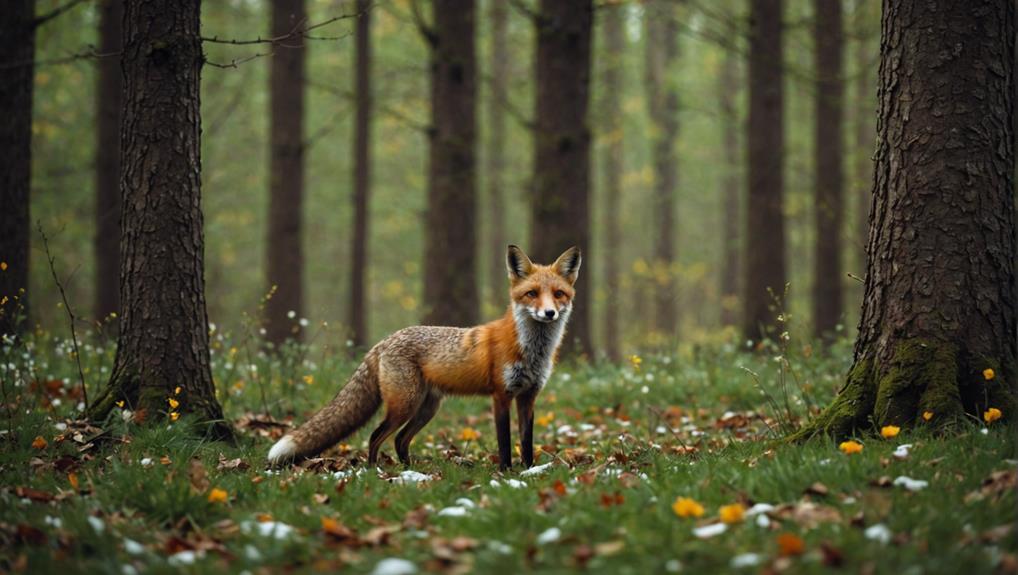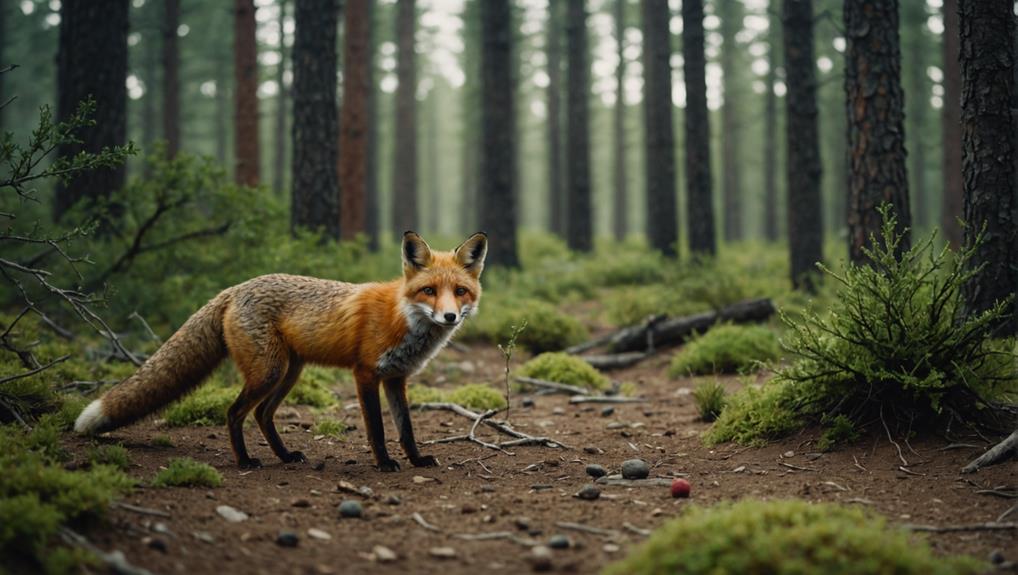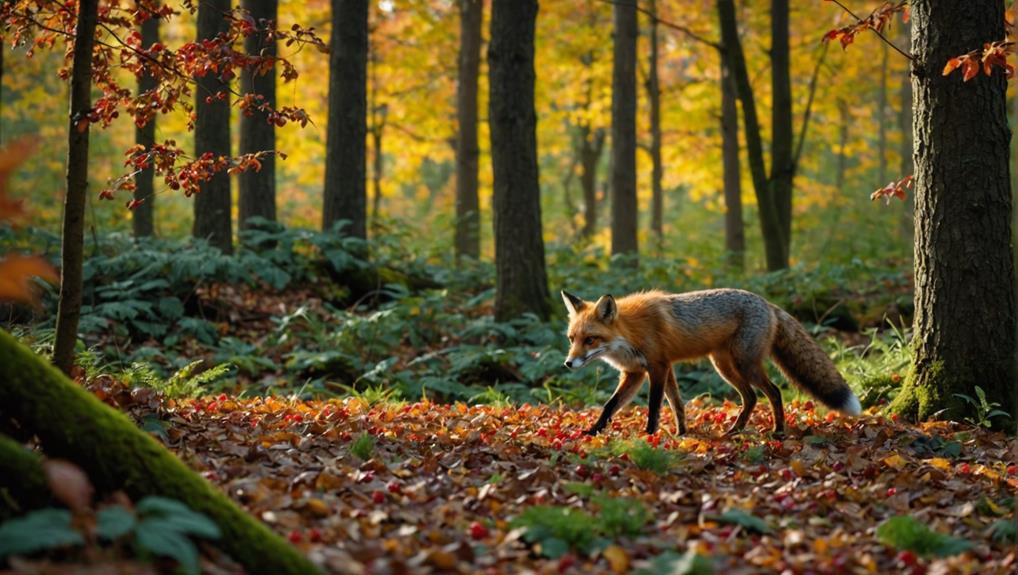Foxes are like culinary adventurers, adjusting their diets based on what's available and the season. In rural areas, they feast on small mammals like voles and rats, while urban foxes get adventurous with takeout and pizza leftovers! Their menu changes throughout the year: spring brings a bounty of insects and greens, while autumn is all about fruits and berries. In winter, they often scavenge human waste or hunt struggling critters. Their flexible eating habits show just how adaptable these clever creatures can be! Stick around, and you'll discover even more about these crafty critters and their intriguing eating habits.
Contents
Overview of Fox Diet
Foxes have a fascinating omnivorous diet that showcases their adaptability to various environments. You might be surprised to learn that their fox diet can change quite a bit depending on where they live. In rural areas, they primarily hunt small mammals like voles and birds, which keeps them active and engaged.
However, in urban areas, you might notice foxes rummaging through trash cans or snacking on leftover pizza slices. Yes, those crafty creatures are just as comfortable scavenging human food scraps! This adaptability is evident across different species, such as the Red fox thriving in diverse habitats.
Seasonal changes also play a huge role in what foxes eat. During spring and summer, they enjoy a buffet of fruits and insects, but come winter, they often have to rely more on scavenging. It's like a game of survival, where they adjust their menu based on what's available.
While small mammals make up the bulk of their meals, they're not picky eaters. Foxes might munch on invertebrates or even take down larger prey if the opportunity arises. So, whether they're in the woods or your backyard, foxes are always ready to adapt their diet to thrive in their surroundings!
Common Food Sources
In exploring the diet of foxes, you'll find that their common food sources reflect their opportunistic feeding habits. These clever creatures have a varied menu that adapts to their environment, ensuring they're well-nourished no matter where they roam.
This adaptability is evident in the way different fox species, such as the Red fox, exploit available resources in both rural and urban settings. Here are three key components of the fox diet:
- Small Mammals: Bank voles, field voles, and brown rats are often on the menu. You'll spot them in both rural and urban settings, making for easy hunting.
- Insects and Invertebrates: Believe it or not, these little critters can make up to 30% of a fox's intake, especially in drier areas. Who knew bugs could be so filling?
- Fruits and Berries: Foxes have a sweet tooth! In fact, studies show that 76% of their stomach contents contain fruits, particularly in the fall when everything is ripe and tasty.
Seasonal Dietary Changes

As the seasons change, so do the dining habits of foxes, and it's pretty fascinating to see how they adapt.
In spring and summer, they feast on an abundance of small mammals, which allows them to capitalize on the high food availability during these months. Their flexible, omnivorous diet enables them to shift their eating patterns effectively.
However, come autumn, they switch it up by munching on berries and fruits to fuel up for winter.
When winter rolls around, these clever critters often find themselves scavenging more, sometimes even raiding your trash can or munching on pet food, proving that even foxes have to get a little creative when food gets scarce!
Spring Food Abundance
Spring bursts forth with a rich array of food sources that foxes enthusiastically exploit, transforming their diets during this vibrant season. As the world wakes up, foxes find themselves in a buffet of delights, making their fox diet more varied and nutritious. This is especially important for female foxes getting ready to welcome their cubs into the world.
Here are three key food sources that foxes indulge in during spring:
- Small Mammals: Vole populations can skyrocket, making these tiny critters a staple for foxes, often dominating their meals.
- Insects: As the weather warms, foxes start snacking on insects and earthworms, adding some crunch to their diets.
- New Plant Growth: Fresh greens aren't just for salads! Foxes nibble on tender plants, rounding out their meals with a bit of fiber.
These seasonal changes not only satisfy their hunger but also set the stage for a successful summer.
Winter Scavenging Strategies
Winter's chill prompts foxes to become savvy scavengers, adapting their diets to survive the harsh conditions. As food becomes scarce, foxes turn to urban areas, where they can find leftover meals and discarded trash. It's like a buffet for these clever critters! They often feast on carrion and other waste, making the most of what's available.
Interestingly, hedgehogs make up about 13% of their winter diet, as research shows. With fewer small mammals around, foxes get creative, munching on invertebrates and any fruit they can find. This opportunistic behavior is key to their survival.
Here's a quick look at their winter food sources:
| Food Source | Percentage | Habitat Type |
|---|---|---|
| Carrion | 40% | Urban Areas |
| Hedgehogs | 13% | Gardens |
| Invertebrates | 20% | Fields |
| Fruits | 15% | Woodlands |
| Leftovers | 12% | Residential |
In winter, foxes become resourceful, reminding us that sometimes, the best meals are the ones you find when you think outside the box—or trash can!
Urban Foraging Adaptations
Urban environments offer a unique buffet for foxes, prompting them to adapt their diets with the changing seasons.
These clever critters find ways to thrive, even in the hustle and bustle of city life, with approximately 70% of urban foxes showcasing their adaptability in urban settings.
You might be surprised at how their menus shift throughout the year, reflecting their flexible diets that include a significant amount of food scraps.
- Winter foraging: When the chill sets in, foxes turn to human food waste and pet food, since natural sources are scarce. Who knew your trash could be a fox's treasure?
- Spring and summer feasting: As the weather warms, foxes feast on small mammals and birds to support their growing cubs. Talk about a family meal!
- Autumn harvest: When fall rolls around, fruits and berries become a tasty treat, rounding out their omnivorous diets.
These seasonal shifts in urban fox diets showcase their opportunistic foraging skills.
They adjust their eating habits based on what's available, proving that adaptability is key to survival.
Urban vs. Rural Diet
When you think about foxes, you might picture them hunting in the wild, but urban foxes have a different game plan.
They often scavenge through our trash, munching on leftover pizza or the occasional rat, while their rural buddies are busy hunting voles and birds.
This shift in diet raises some eyebrows, as munching on human scraps could lead to some health hiccups that mightn't be a concern for their more traditional counterparts.
Urban Food Sources
The dietary habits of foxes vary dramatically between urban and rural environments, reflecting their ability to adapt to available resources. Urban foxes have become quite the opportunistic eaters! Instead of hunting small mammals and birds like their rural cousins, they often scavenge for food items in dustbins, making the most of human leftovers.
Here are three key food sources for urban foxes:
- Human Food Waste: You'll often find them rummaging through garbage cans, enjoying everything from pizza crusts to leftover takeout.
- Scavenged Pets: With pets roaming around, urban foxes sometimes indulge in pet food, giving them a tasty treat that rural foxes miss out on.
- Fruits and Berries: Gardens and parks offer a buffet of fruits and berries, adding a sweet twist to their diet.
This shift means urban foxes consume about 60% of their food from human sources, which can impact their health.
It's fascinating how these clever critters adapt, but it also raises questions about the long-term effects of such a diet. Urban life certainly brings unique challenges and opportunities for these resourceful foxes!
Rural Hunting Strategies
Rural foxes rely on a range of hunting strategies that reflect their natural environment.
These crafty critters primarily hunt small mammals like bank voles and field voles, which are plentiful in the countryside. When you think about their diet, picture a small, furry creature dashing through the grass—this is what rural foxes are after! Their hunting isn't just about catching dinner; it's a seasonal adventure. As the populations of small mammals shift throughout the year, these foxes adjust their hunting tactics accordingly.
In contrast to their urban cousins, who scavenge for leftover pizza and fries, rural foxes stick to their instinctive ways. They also munch on small birds and rodents, keeping their diet focused on natural prey.
While urban foxes enjoy a more diverse menu, thanks to human food scraps, rural foxes find their meals in the wild. So, if you ever spot a fox in the countryside, remember that it's on a mission, relying on its sharp instincts to fill its belly with nature's bounty, rather than relying on takeout! Isn't that a fun thought?
Dietary Health Impacts
Urban foxes scavenge human food waste, leading to a diet that's far less natural than their rural counterparts. You might be surprised to learn that this reliance on scraps can really affect their health.
While rural foxes enjoy a balanced menu of small mammals and birds, urban foxes often nibble on whatever people leave behind.
Here's how their diets can impact their well-being:
- Obesity Risks: The unhealthy snacks found in urban areas can contribute to weight gain, making it harder for foxes to hunt or escape danger.
- Vitamin Deficiencies: Urban diets may lack essential nutrients, leading to health problems that rural foxes, with their diverse meals of voles and fruits, generally don't face.
- Ecosystem Disruption: The growing urban fox population can cause more human-wildlife conflicts, as these foxes adapt to a less natural lifestyle.
Impact of Environmental Factors

Environmental factors play an essential role in shaping the diets of foxes, and you can see this variation across different regions and climates. Depending on where they live, foxes eat a surprisingly diverse diet. In cooler areas, small mammals like mice or rabbits might be the main course, while in warmer climates, you could find them munching on more invertebrates. Yep, bugs are on the menu too!
Interestingly, as you climb higher in elevation, the food options change. You'll notice fewer medium-sized mammals, but more small critters appear. And when it rains more, guess what? Foxes feast on fruits! That's right, a juicy berry can be a delightful snack.
Urbanization and agriculture also shake things up. The Human Footprint Index shows that as cities grow, large mammals become scarce, but birds and fruits start popping up in urban fox diets.
Scavenging and Opportunistic Feeding
Foxes are remarkable scavengers, showcasing their adaptability by feeding on whatever's available. You might spot them rummaging through trash cans in urban areas, grabbing a bite of leftover pizza or pet food. Their opportunistic feeding habits are truly impressive.
Here are three ways foxes make the most of their surroundings:
- Human Food Waste: They often scavenge for scraps from our garbage, turning our leftovers into their meals.
- Carrion: Foxes aren't shy about digging into decomposed remains, even disrupting burials if it means a free meal!
- Caching Behavior: They cleverly store food for later, ensuring they've a snack stash when times get tough.
In urban habitats, foxes really rely on human-generated food, which helps them thrive.
When the weather gets harsh, they'll increase their scavenging efforts, snatching up anything from hedgehogs to carrion. It's a wild world out there, but these crafty creatures know how to survive!
Their flexible eating habits highlight their intelligence and adaptability, reminding us that nature always finds a way, even if it means diving into our leftovers.
Who knew foxes could be so resourceful?
Feeding Behavior of Foxes

The feeding behavior of these cunning animals reveals just how adaptable they are to their surroundings. You might be surprised to learn that local foxes have a varied diet, which shifts based on what's available. They're opportunistic eaters, snacking on everything from small mammals to fruits, particularly when the weather changes. In urban areas, they often scavenge human food waste, turning a pizza slice into a gourmet meal!
Here's a quick look at some key aspects of their feeding behavior:
| Behavior Type | Description | Example |
|---|---|---|
| Opportunistic Eating | Consumes available food, including plants and animals | Eating insects in summer |
| Caching | Stores food for later use | Hiding a small rodent |
| Seasonal Variation | Diet changes with the seasons | More fruit in spring |
| Urban Scavenging | Takes advantage of human leftovers | Finding food in trash |
| Climate Influence | Diet shifts based on climate conditions | More mammals in winter |
This adaptability is essential for the survival of the fox population, showing just how clever these creatures truly are! So next time you spot a fox, remember, it's not just hunting; it's strategizing its next meal!
Ecological Role of Foxes
In the intricate web of nature, foxes serve as key players that help maintain ecological balance. These clever critters have a significant impact on their environments through their diverse diets and hunting habits.
Here are three important ways foxes contribute to the ecosystem:
- Population Control: By preying on small mammals, especially rodents, foxes help keep those populations in check. Without them, you might find yourself in a world overrun by pesky little creatures!
- Nutrient Cycling: As opportunistic feeders and scavengers, foxes munch on carrion and waste. This not only aids in decomposition but also supports healthy soil—talk about recycling!
- Seed Dispersal: With their omnivorous diet that includes fruits, foxes play a role in spreading seeds. This promotes plant diversity, ensuring our ecosystems remain vibrant and thriving.
Foxes aren't just hunters; they're crucial links in food webs. Their presence indicates a healthy environment, whether in urban areas or rural landscapes.
Final Thoughts
So, there you have it! Foxes are pretty adaptable when it comes to their diets, munching on everything from small mammals to fruit. Did you know that they can eat up to 5,000 calories a day during winter? That's like a human gobbling down a whole birthday cake! Whether they're scavenging in the city or hunting in the wild, these clever critters play a crucial role in their ecosystems. Next time you spot one, remember, they're just out there living their best life!














